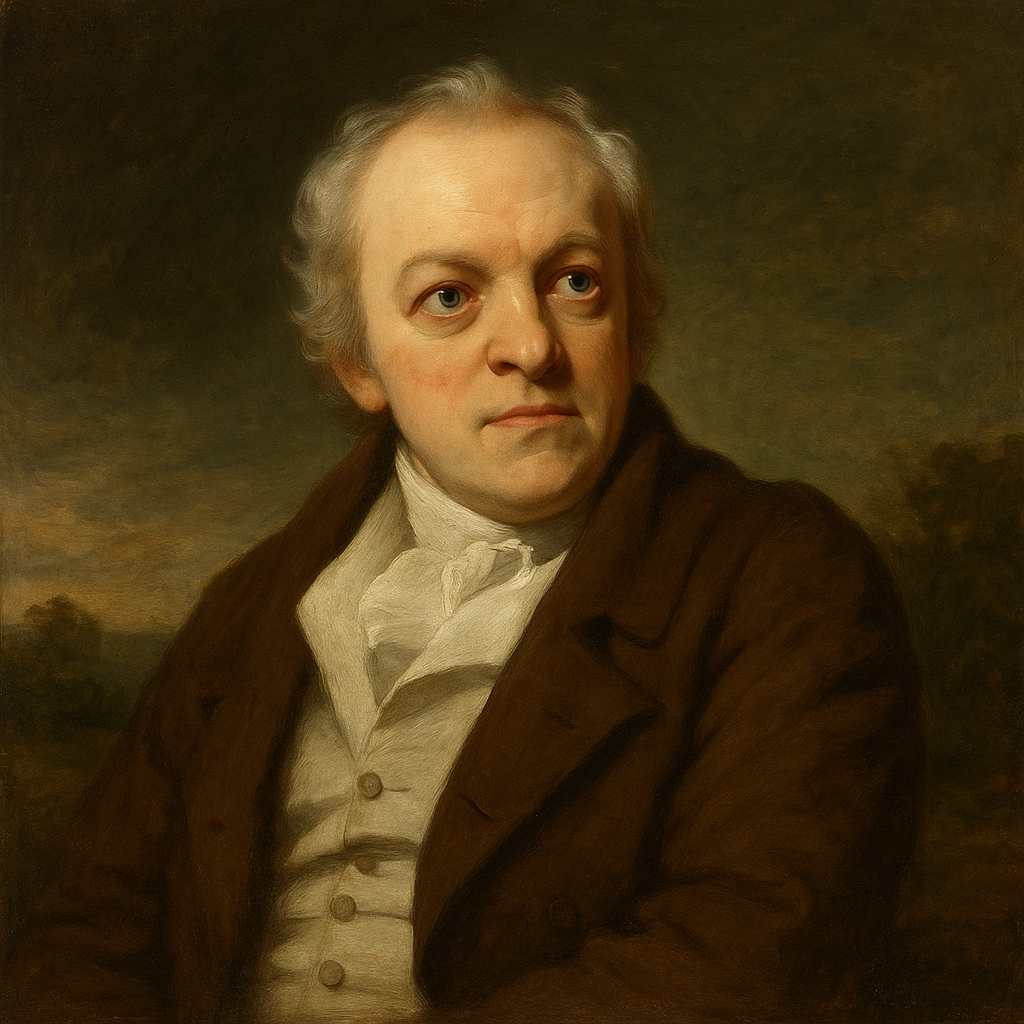The Tyger
William Blake
1757 to 1827

Tyger Tyger, burning bright,
In the forests of the night;
What immortal hand or eye,
Could frame thy fearful symmetry?
In what distant deeps or skies.
Burnt the fire of thine eyes?
On what wings dare he aspire?
What the hand, dare seize the fire?
And what shoulder, & what art,
Could twist the sinews of thy heart?
And when thy heart began to beat.
What dread hand? & what dread feet?
What the hammer? what the chain,
In what furnace was thy brain?
What the anvil? what dread grasp.
Dare its deadly terrors clasp?
When the stars threw down their spears
And water'd heaven with their tears:
Did he smile his work to see?
Did he who made the Lamb make thee?
Tyger Tyger burning bright,
In the forests of the night:
What immortal hand or eye,
Dare frame thy fearful symmetry?
William Blake's The Tyger
William Blake's poem "The Tyger," from his collection "Songs of Experience" (1794), stands as one of the most iconic works in English literature. This powerful piece explores profound questions about creation, divinity, and the nature of good and evil. Through its vivid imagery and probing questions, Blake invites readers to contemplate the complexities of existence and the paradoxes inherent in the idea of a divine creator.
"The Tyger" consists of six quatrains, each following a consistent rhyme scheme (AABB) and a largely consistent meter (trochaic tetrameter). This rhythmic structure, reminiscent of a chant or incantation, lends the poem a hypnotic quality that enhances its thematic exploration. The repetition of the first and last stanzas, with a slight variation in the final line, creates a circular structure that emphasizes the unresolved nature of the questions posed throughout the poem.
The central image of the tyger serves as a complex symbol throughout the poem. The tyger, with its "fearful symmetry," represents a powerful, awe-inspiring, and potentially dangerous aspect of creation. Blake's use of fire imagery ("burning bright," "burnt the fire of thine eyes," "dare seize the fire") associates the tyger with both destructive and creative forces, evoking ideas of passion, energy, and transformation. The poem's setting, "the forests of the night," suggests a realm of mystery and potential danger, contrasting with the implied innocence and gentleness of the lamb mentioned later in the poem. This juxtaposition is crucial to understanding Blake's exploration of duality in creation.
Throughout the poem, Blake poses a series of questions about the creation of the tyger, using the metaphor of a blacksmith crafting a fearsome beast. This extended metaphor is developed through references to various tools and processes of metalworking: "What the hammer? what the chain, / In what furnace was thy brain?" and "What the anvil? what dread grasp / Dare its deadly terrors clasp?" These vivid descriptions not only create a powerful image of the tyger's formation but also raise questions about the nature of the creator. The repeated use of "dare" suggests that the act of creating such a creature is audacious, perhaps even transgressive.
One of the poem's central themes is the apparent paradox in the idea of a single divine creator responsible for both the gentle and the fierce aspects of nature. This is most explicitly addressed in the lines: "Did he smile his work to see? / Did he who made the Lamb make thee?" Here, Blake references "The Lamb," another poem from his collection "Songs of Innocence," which presents a vision of gentle, benevolent creation. By contrasting the lamb with the tyger, Blake forces readers to grapple with the coexistence of good and evil, innocence and experience, in the natural world and, by extension, in human nature.
"The Tyger" engages with several philosophical and theological debates of Blake's time, including the problem of evil (how can a benevolent God create a world that contains both good and evil?), the nature of divinity (is God solely a force of goodness, or does the divine encompass both creative and destructive aspects?), and the limits of human understanding (can mortals truly comprehend the nature and motivations of a divine creator?). By posing these questions without providing definitive answers, Blake invites readers to engage in their own philosophical inquiry.
Blake employs several linguistic devices to enhance the poem's impact. Alliteration, as in "Tyger Tyger," "distant deeps," and "dare he aspire," creates a musical quality and emphasizes key concepts. The repetition of "What" at the beginning of many lines creates a sense of urgency and wonder. The use of archaic language, such as "thy" and "thine," lends a formal, almost biblical tone to the poem, further emphasizing its profound philosophical and theological inquiries.
"The Tyger" remains a powerful and enigmatic poem that continues to provoke thought and analysis. Through its striking imagery, probing questions, and exploration of fundamental dualities, Blake crafts a work that transcends simple interpretation. The poem invites readers to contemplate the nature of creation, the limits of human understanding, and the complex relationship between divinity and the natural world.
By leaving its central questions unanswered, "The Tyger" becomes a mirror for the reader's own beliefs and doubts. It stands as a testament to Blake's artistic vision and his ability to distill complex philosophical and theological concepts into a work of enduring poetic power. The poem's enduring appeal lies in its ability to challenge readers across generations to consider the fundamental questions of existence, creation, and the nature of good and evil. In doing so, it exemplifies the power of poetry to engage with the most profound aspects of human experience and thought.
This text was generated by AI and is for reference only. Learn more
Want to join the discussion? Reopen or create a unique username to comment. No personal details required!



Comments
No comments yet. Be the first to comment!